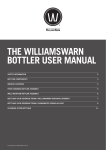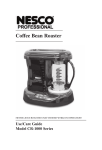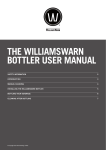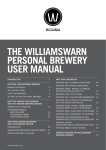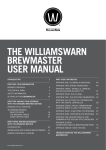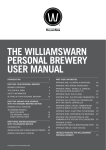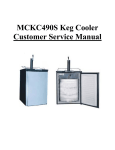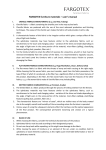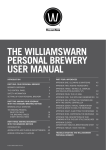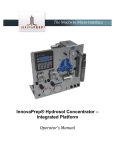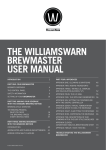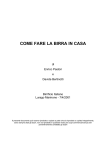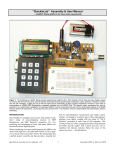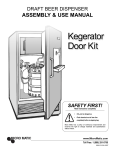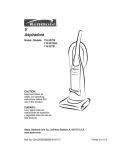Download PERSONAL BREWING WITHOUT COMPROMISE
Transcript
PERSONAL BREWING WITHOUT COMPROMISE ThE TECHNOLOGY 2 PERSONAL BREWING VS HOMEBREWING 5 PERSONAL BREWING VS COMMERCIAL 10 OUR brewing methods 12 Our Ingredients 13 SHORT INSTRUCTIONS 14 blind tasting results 15 The asia beer awards 2012 17 THE ASIA BEER AWARDS 2013 19 General Dimensions © Copyright 2013 WilliamsWarn NZ Ltd 20 1 THE TECHNOLOGY The WilliamsWarn Personal Brewery has six main technical features that, when combined together, create the world’s first all-in-one brewing appliance. This combination then allows you to make the freshest beer on the planet with minimum effort. 1. The Stainless Steel Pressure Vessel level of the beer. During fermentation this is set at about 1 bar (14.5 psi), depending In order to eliminate the problem of a long on the beer style and carbonation is carbonation time, as is standard practice in usually achieved after 24 hours, after which time the continued CO2 produced homebrewing (1 week if kegging, 4 weeks if bottling), the tank needs to be a pressure by the yeast is emitted by the VPRV to the vessel to enable natural carbonation atmosphere. This eliminates the need for to occur during fermentation, not after kegging or bottling, because the beer is fermentation. In order to be a strong and already carbonated on the first day. therefore safe pressure vessel, our tank is The tank cone is polished to a mirror made out of rolled stainless steel. The rim finish in order to enable better settling of of the tank is investment cast in stainless yeast and haze particles into the sediment steel and the lid screws onto the rim to seal bottle, at the end of fermentation and after securely. The seal is a circular silicon seal, the clarification process. to ensure maximum pressure retention. The tank pressure during production 2. The Temperature reaches a maximum of about 1 to 1.5 bar Control System pressure (14.5-22 psi) but it can tolerate Poor temperature control of any over 3 (44 psi) bar pressure. fermentation vessel leads to either long “The tank cone is polished to a mirror finish in order to enable better settling of yeast and haze particles into the sediment bottle” There are two pressure relief valves connected to the tank that safety-release at 3 bar (44 psi). One is positioned inside the tower and one on the tower control panel. The one on the tower control panel is actually a variable pressure relief valve (VPRV), and it can be adjusted by hand. This VPRV is the important device that allows the brewer to adjust the pressure build-up in the tank during fermentation and thus control the natural carbonation The brewer sets the temperature he or she requires, using a digital temperature controller on the control panel. The controller also reads the temperature of the tank, so that the brewer can be sure that the correct temperature is achieved. “All the brewer needs to do is set the fermentation temperature target and the controller will maintain fermentation within 1°C” This digital controller controls the refrigeration and heating systems to ensure perfect temperature control at all times. fermentation times if the tank get too cold When the yeast is pitched into the full or the production of “higher alcohols” (also tank, the contents are about 25°C (77°F). known as fusel oils) in the beer if the tank The brewer then sets a fermentation gets to warm. These longer chain alcohols temperature target between 10°C and give the classic homebrew headache, 26°C (50°F-79°F) using the temperature a common experience for those who controller. The refrigeration will then homebrew with a heat-belt or heat-pad in come on to achieve set-point. The fridge a cupboard. It is therefore important that is situated in the tower and is a 131 watt the WilliamsWarn Personal Brewery has compressor refrigerator (at -5°C/23°F perfect temperature control around the evaporation temperature) that uses vessel at all times of the brewing process. refrigerant R134a to chill a glycol bath. Commercial breweries also control their The glycol circulates around the cone of fermentation temperature within tight the vessel to maintain the temperature. parameters as dictated by the beer recipe. The heat transfer is optimized and cooling The personal brewery therefore has both is achieved in good time. Once the heating and cooling means and a controller temperature set-point is achieved, the to dictate what temperature the vessel controller turns the refrigerator off. The should be, at any time during production dry yeast then starts to ferment a few and consumption. hours after temperature is achieved. 2 During fermentation, the yeast produces about 3 watts of heat due to their metabolic activity, so depending on the ambient temperature, cooling will come on 1°C (1.8°F) above set-point and bring it down again and then turn off. If during fermentation the ambient surroundings are cold (e.g. in winter) and the tank gets 1°C (1.8°F) below set-point, a heater controlled by the digital controller warms the glycol up gently until set-point is achieved. In this way all the brewer needs to do is set the fermentation temperature target using the temperature set-point and the controller will maintain fermentation within 1°C (1.8°F) below and 1°C (1.8°F) above set-point. Therefore fermentation of a normal 4% alcohol (by volume) ale at e.g. 20°C (68°F) can be finished in 4-5 days as it should be and not slowly over 2-3 weeks as many homebrewers incorrectly think is acceptable. A better beer flavour is achieved and fermentation proceeds in proper time, like a commercial brewery, as the yeast health is totally catered for. When the brewers are ready to chill the beer down to drinking temperature, again all that is required is for him or her to turn the temperature set-point down and the controller will do the rest. The refrigeration will come on and reduce the beer down to a minimum of 1°C (34°F). If the ambient temperature is less than about 1°C (34°F, e.g. in winter) and the beer gets 1°C (1.8°F) below set-point, the heater will come on and maintain set-point as it does during fermentation. So it doesn’t matter if it is hot or cold, the WilliamsWarn Personal Brewery maintains temperature set-point at all times during the processing. The tank is insulated with thick polystyrene to achieve minimum heat transfer from the ambient temperature to the beer. Polystyrene was chosen as it has a low thermal conductivity and is more easily recycled compared to some other insulating materials. The insulation has bright annealed stainless steel cladding around it, as one would expect for a brewery vessel. clarification agent is so awesome and our keg or bottle for carbonation. Again, all these transfers cause oxidation and involve tank so small!) that we don’t need to filter more time, effort and cleaning. the beer, and can then drink it directly out of the tank. Thus we at WilliamsWarn “Our clarification is so good... have gone one-step further than a modern brewery and have now combined the that we don’t need to filter the Finished Beer Tank with the Uni-tank. beer, and can then drink it Since we drink out of it, you can say we’ve also combined the keg and the bar as directly out of the tank.” well. We could have called this invention a Commercial breweries on the other hand Combi-tank or Multi-tank or Brewery-Bar often combine fermentation and maturation but went with the name Personal Brewery in vertical vessels with cones at their bases, instead, as all the steps that occur in a brewery from fermentation onwards (and at so that the yeast and other sediment can be taken off the beer at the bottom, without the bar!) can be done in the one tank to the same quality and in the same time. moving the beer. These are called UniSo our personal brewery is a conically tanks. They remove the yeast from the designed tank, which ends at a stainless bottom and then transfer the remaining steel valve with a sediment collection bottle beer through filters and buffer tanks and under it. When the bottle is full of sediment finished beer tanks before transferring it to at the end of clarification, all you need to packaging, but at least they have stopped do is close the valve above the bottle and one transfer step at the beginning. Like a take the bottle off. There is a small release combined fermentation/maturation vessel of pressure from the bottle, but nothing (Uni-tank), we at WilliamsWarn have a sediment removal mechanism to remove all extraordinary and thus it is an easy way to the yeast and clarification sediment without take away all sediment while the tank is still under pressure. This is a critical part having to take the beer out of the vessel. of our invention. The bottle is made out of Our clarification is so good (because our 3. The Sediment Removal System Homebrewers often use flat-bottomed vessels to ferment in, and so need to siphon the beer into another vessel to take the beer off the yeast. This creates beer oxidation, more work and an increased risk of infection. They then often clarify the beer in the 2nd flat bottomed vessel before siphoning again into a flat bottomed 3 a special plastic that is BPA-free, has high impact resistance, is resistant to staining and won’t retain odours. It can withstand sub-freezing to boiling temperatures (min temperature: -40°C/-40°F) and is dishwasher safe if away from the heating element (max temperature: 100°C/212°F). 4. The Clarification System After fermentation, much of the yeast settles into about half of the sediment collection bottle. We then clarify the beer without having to transfer the beer anywhere. This was a major hurdle that needed to be overcome to enable us to have an all-in-one system. “12 hours after clarification, 99% of the yeast and protein haze material has sedimented into the collection bottle” We use a CO2 cylinder sitting inside the tower to force 40-50ml of a special clarification agent out of a small dosing pot and into the beer. This clarifying agent actually gets forced into the beer outlet pipe, but instead of going out the beer tap, which is closed, it is forced back into the beer tank, so that the clarification agent gets forced vertically into the beer. We continue to bubble this clarification agent into the beer from the bottom with CO2, for 10 seconds to mix it well. By this special design, the agent mixes perfectly so that it is evenly dispersed throughout the 23 litres of beer and it reacts immediately with protein haze and yeast cells and it all starts to fall down the tank. 24 hours after clarification, much of the yeast and protein haze material that was remaining in the beer has also sedimented into the sediment collection bottle. We repeat the clarification step a second time and wait another 24 hours. The beer is then crystal clear and ready to consume. We then simply close the valve and remove the bottle and dump the material (that would have made our beer cloudy) down the drain. It’s all out of the tank, never to return. with each drop maintaining proper carbonation. 6. Draft dispense mechanism with flow-control The final important part of the technology is the beer tap. Because the beer is under pressure and the tap is close to the tank, we need to be able to restrict the flow so that the beer doesn’t flow out of the tap too quickly and cause over-foaming in the glass. In addition, because we can make unlimited beer styles in the personal brewery, the beer in the tank 5. The Gas Dispense System can be a highly carbonated wheat beer or a low carbonated English ale, so be Once the beer is cold and clarified, it is sitting at different tank pressures. We ready to consume. However if we opened have therefore used a beer tap with a the beer tap and started pouring beer, as flow-control mechanism to account for we emptied the tank over time, the tank these two issues. This enables the brewer pressure would start to decrease and the to control the speed of the pour, so that beer would become flat over time. This is he or she can always get the perfect pour because as the headspace becomes larger and the beer volume smaller, the CO2 in the into the glass. The mechanism is simply beer moves into the headspace and the beer a small lever on the side of the tap that starts to lose its fizz. So what we need to do can be easily adjusted before or during a is maintain the pressure in the headspace pour, to restrict or open-up the flow inside as the level decreases, with an external the tap as it is dispensed. In addition, source of CO2. Then the natural CO2 in the by pulling the top of the tap backwards, beer stays in the beer and it remains fully you can add more foam to the top of your carbonated right until the last drop. beer in your glass. We use a CO2 cylinder that is placed in the machine to help push the beer out the So there you have it, six technical features beer tap and maintain the same pressure that combine to give the consumer a in the tank from the first to the last drop. product that has never been on offer After the clarification agent has been before. Cold, clear, perfectly carbonated, bubbled into the beer to help it clear, the commercial quality draft beer in 7 days, brewer must connect this CO2 bottle to the just like a modern brewery. tank at the correct pressure by opening a Download our user manual for valve on the control panel. It simply stays more detailed information. like that until the beer is all consumed, 4 PERSONAL BREWING VS HOMEBREWING Homebrewing in its current form has 12 main problems that have needed solving for a long time. Here they are, and how the WilliamsWarn has solved them. 1. THE LONG CARBONATION PROCESS By far, the biggest problem in homebrewing is that the homebrewer allows all the gas produced by the yeast during fermentation to escape through an air lock into the atmosphere and they therefore initially produce flat, un-carbonated beer. The homebrewer must then transfer the beer into another container to carbonate it. This not only requires more work and equipment, but an extra time period must be added onto the process to carbonate the beer. This is not how commercial breweries operate and is therefore not consistent with optimal brewing methods. For homebrew transferred into bottles after the first fermentation, it takes about 4 weeks to carbonate the flat beer and for homebrew transferred into kegs it takes at least 1 week. Commercial breweries do not require this extra processing step and this long extended time associated with carbonation, so homebrewing is at a major disadvantage with this first problem alone. The WilliamsWarn Personal Brewery solves this problem, and like a commercial brewery, there is no long extra carbonation processing step. It just simply occurs during the primary fermentation. Breweries have a few options with regards to carbonating beer. Most large commercial breweries around the globe collect the CO2 produced by the yeast during primary fermentation off the top of the fermenter, compress it and store it in liquid form, in what is called a Carbon Dioxide Recovery Plant. They then dose it back as a gas into the beer when they filter the beer into a tank, the day before packaging. Thus is takes them seconds to top up the beer with the CO2 they want in the final beer. It doesn’t take 1-4 weeks as in the homebrewing world. Homebrewers obviously cannot do this, but there is another option that has been overlooked, until now, and that is the option of a “Pressure Fermentation”. There are several types of pressure fermentations. A few breweries wait until the end of fermentation and then close the tank and allow the pressure to build up as the last days of fermentation occur. The pressure builds up as the yeast consumes the last of the sugars and the beer gets carbonated as the gas has nowhere else to go but into the beer. Some breweries close the vessel at the half way mark and release the excess gas they don’t need after a certain pressure is achieved, corresponding 5 to the carbonation level they want in the beer. Germans also have a method called “krausening” where they add some fresh wort (that’s the extract from the malted barley that gets turned into beer) to an almost finished fermentation to keep the fermentation going, close the tank and then allow the yeast to gas the beer up. “We allow carbonation of the beer to occur on the first day by letting the pressure build up naturally to the level we want and allowing the rest to vent as fermentation continues.” A few select breweries and many homebrewers bottle the flat beer and add some sugar to each bottle (or to the beer before bottling) and then cap them all. The residual yeast in the beer eats the sugar over 4 weeks and the CO2 produced carbonates the beer. In all these cases, the yeast is naturally carbonating the beer. At WilliamsWarn we allow carbonation of the beer to occur on the first day by letting the pressure build up naturally to the level we want and allowing the rest to vent as fermentation continues. All we need to do is turn a little variable pressure relief valve (VPRV) to the setting we want and it’ll take care of itself. So we make it a Pressure Fermentation from the beginning. You can do it at the middle or end but it’s more convenient to do it at the beginning by just closing the lid and setting the VPRV where it’s required, after adding the ingredients. We only need about 5% of the CO2 the yeast produces to get to a typical level of carbonation, but without it the beer is flat and has to go through some other laborious and time consuming carbonation process. When the fermentation is finished, we have the bubbles we want in the beer already and all we need to do is mature it warm for one day, cold for one day more, clarify it over one final day and then enjoy it. Most large breweries are making beer in this kind of time frame. The idea that beer needs to be matured for months harks back from the 1800’s prior to refrigeration and decent clarification methods. But beer is best fresh so there’s no point waiting for it to get old. “WilliamsWarn offers the homebrewer an all-in-one system that doesn’t need the beer to be transferred out of it for carbonation” This Pressure Fermentation method is technically used in some breweries (e.g. German Weiss Beer) but is less common now due to the ease of storing the CO2 produced by the yeast in modern recovery plants. As our tank is only about 55cm tall (22 inches), the pressure the beer is fermented under is about the equivalent of making the tank 10 meters tall, which is a normal sized tank for an average brewery. So we are in fact fermenting the beer under normal brewery circumstances when looked at in this way. The yeast just thinks it’s in a normal 10m high fermenter. So we’re making beer like the commercial guys. The gas level can be controlled exactly during fermentation, because we can set both the temperature and pressure to achieve the carbonation we want. This relationship is explained by the famous Henry’s Gas Law and we choose to have low, normal or high carbonation depending on the beer style we’re making. It is hard to get accurate carbonation with traditional bottle conditioning as it depends on the health of the remaining yeast in the flat beer and the amount of sugar added. Therefore exploding bottles, frothy beer and under-carbonated beers are all experienced in standard homebrewing. With a WilliamsWarn Personal Brewery, you can brew like an expert. For instance you can get 5g/l CO2 in the beer like the professionals and know you have it exactly right, by the pressure and temperature readings on the machine. We are the only company on dear planet Earth offering temperature and pressure controlled fermentations to the small scale brewer. WilliamsWarn therefore offers the homebrewer an all-in-one system that doesn’t need the beer to be transferred out of it for carbonation as all homebrewers currently do now (into a bottle or keg). We need to solve the 11 other problems as well (see the other problems explained), but this need to transfer the beer into another vessel for a long carbonation period is the biggie that has always needed overcoming in order to make small scale brewing a more convenient experience. Gassing it up on Day 1 of fermentation all by itself is a lot better than having to clean 60 bottles, rinse 60 bottles, fill 60 bottles with flat beer, add sugar to 60 bottles, cap 60 bottles and then store them for 4 weeks waiting for carbonation, isn’t it? For homebrewers who keg the beer after primary fermentation, it’s also more convenient as there’s now no need for the keg, the large gas bottle, the fridge, the transferring and its resulting oxidation of the beer and the one week wait to gas it up. The WilliamsWarn Personal Brewery is the keg and the fridge. Plus you have the enjoyment of drinking a beer carbonated with CO2 from its own fermentation, like a big brewery, rather than using CO2 produced and bottled from some other source like the oil or sugar industries and all the negative connotations associated with that, like residual flavours in the CO2 and oil contamination (which can affect the foam). And as an extra bonus, this all follows the German Purity Law of 1516 (the CO2 in the beer, came from the beer). Say goodbye to bottles and kegs everybody…..you can’t stop progress. 2. POOR TEMPERATURE CONTROL LEADING TO A LONG FERMENTATION TIME The second main problem with homebrewing is poor temperature control during primary fermentation. Breweries control the fermentation temperature approximately within +/- 1 degree Celsius but this is not the case for most homebrewers. Homebrewers often place the primary fermentation vessel in a room, storeroom or garage, which results in large fluctuations in temperature from day to night and season to season. This invention makes it possible for home brewers to mimic production of famous ales and lagers by fermenting at correct temperatures for the beer style or brand In the cases where the fermenting beer becomes colder than target temperature, it extends the fermentation time greatly. The yeast does not like the large swings in temperature and if it gets too cold it may not recover when reheated. So instead of taking 4 days to ferment as in a commercial brewery, a normal strength beer can take 2 weeks to ferment, for a homebrewer and that’s a huge negative which affects both the time involved and 6 the beer quality. Some homebrewers counteract the effect of the cold by using a heat-belt or light bulb or electric blanket, but this can have the opposite effect and warm the beer up too much. Beer fermenting too warm can create what’s known as fusel oils (long chain alcohols) which can give the famous headaches associated with homebrewing. So in order to ferment like a brewery, the fermenting beer temperature must be controlled very closely to the target temperature. The WilliamsWarn Personal Brewery has both heating and cooling means which are controlled by a digital controller to within 1 degree Celsius of the set-point. Fermentation then progresses steadily. For a 4% alcohol beer starting at 10°Plato (1.040 Specific Gravity) and finishing at 2°Plato (1.008 Specific Gravity) and fermenting at 20°C (68°F), one should expect a commercial brewery and a Personal Brewery to achieve at least a rate of 2°Plato (1.008 SG units) per day on average and therefore be finished in 4 days. So 1% of alcohol per day. For higher alcohol beers starting at a higher Plato (Specific Gravity) or beer fermenting colder (e.g. lagers), the time will be longer, but 2°Plato (1.008 SG units) per day on average is still approximately an acceptable fermentation rate in these instances. In addition, due to the vessels ability to control temperature, a wider range of beverage types can be produced, as the temperature of the contents can be set at a variety of temperatures at different times during the process, depending on what beverages are being made and at what stage the brewing process is at. This invention makes it possible for home brewers to mimic production of famous ales and lagers by fermenting at correct temperatures for the beer style or brand. 3. A LONG CLARIFICATION PROCESS Some homebrewers often conduct long clarification periods before carbonating their beers. This is due in part to brewing practices of the 19th Century, whereby beer was kept for long periods of time in barrels to help it clear. Many homebrewers think that this long maturation period is still necessary and that beer somehow resembles wine or whiskey in needing time to both mature and clear. Beer is in fact best fresh and unless there is an off-flavour that needs time to diminish (like tannins in wine), then long maturations are not required. Modern methods and clarification agents can vastly accelerate the clarification process and modern breweries also filter their beers so that a batch of beer can be clear in hours rather than months. At WilliamsWarn we use a clarification agent and process that requires 24 hours for the beer to be clear. It occurs in the vessel so no transfers are required and the beer is crystal clear when first consumed. This helps us make our beers in the same time-frame as a modern brewery. out of the vessel. The clarification is so good we don’t need to filter it so can drink the beer direct out of the tank. “Cold, clear, perfectly carbonated beer in 7 days, just like the big boys.” We have used a conically designed tank which ends at a valve with a bottle under 4. No sediment removal it. After fermentation, much of the yeast mechanism settles into about half of the bottle. We then clarify the beer without having Homebrewers often use flat-bottomed to transfer it anywhere. We use a CO2 vessels to ferment in, and so need to siphon the beer into another vessel to take cylinder sitting inside the tower to force the beer off the yeast. It creates oxidation, 40-50ml of a special clarification agent out of a small dosing pot that is built more work and an increased risk of infection. They then often clarify the beer into the control panel and into the beer, whilst the beer is still under pressure. in the 2nd flat bottomed vessel before This clarifying agent actually gets forced siphoning again into a flat bottomed keg into the beer outlet pipe, but instead of or bottle for carbonation. Again, all these going out the beer tap which is closed, transfers cause oxidation and it takes it is forced back into the beer tank. The time, effort and several vessels and it all clarification agent gets forced upwards has to be cleaned. into the beer vertically. We bubble this Commercial breweries on the other clarification agent into the beer for 10 hand often combine fermentation and seconds from the bottom with CO2 to mix maturation in vertical vessels with cones it well. By this special design, this mixes at the base, so that the yeast and other sediment can be taken off the beer at the the agent perfectly so that it is evenly dispersed throughout the 23 litres of beer bottom, without moving the beer. They and it reacts immediately with protein then transfer the beer through filters haze and yeast cells and it all starts to fall and buffer tanks and finished beer tanks before transferring to packaging but at down the tank. least they have stopped one transfer step 24 hours later, 99% of yeast and at the beginning. protein haze material that hadn’t settled Like a combined fermentation/ naturally at the end of fermentation, maturation vessel, we at WilliamsWarn is also sedimented into the sediment have a sediment removal mechanism collection bottle. We repeat this step one to remove all the yeast and clarification more time and then simply close the valve sediment without having to take the beer and remove the bottle and dump the material that would have made our beer cloudy, down the drain. It’s all out of the tank, never to return. So... cold, clear, perfectly carbonated beer in 7 days, just like the big boys. 5. Too much work Traditional homebrewing involves too much work. It’s one of the major issues with the hobby. There are too many transfers and too many things to clean and sterilise. Bottle conditioning is particularly laborious. As stated in Problem 1, who really wants to clean 60 bottles, rinse 60 bottles, fill 60 bottles with flat beer, add sugar to 60 bottles, cap 60 bottles and then store them for 4 weeks waiting for carbonation? The WilliamsWarn Personal Brewery requires about 1 hours work on Day 1, then 5 seconds work on Day 4, then 5 minutes work on Day 4½, then 5 minutes work on Day 5½ and then 10 seconds work as you open the tap and pour the fruits of your labour into your favourite glass. That’s it. 6. You need experience to make a good beer If you start homebrewing, there’s a good chance your first batch doesn’t come out as good as you’d like. Over time, with effort and patience, you get better, learn what not to do, and start to make a better beer. On the other hand, the number of ex-homebrewers in countries like New Zealand, Australia, Canada and the U.K. is enormous. But that means they gave up due to disappointment, the hobby not delivering the dream. The WilliamsWarn personal brewery is designed to be idiot-proof. The first time you use it, you’ll make a great beer. The quality ingredients and design of the machine combine to deliver what all the ex-homebrewers wanted, a great tasting beer made the first time. Okay, it costs more than a plastic bucket and a box full of bottles, but a great hobby always requires decent equipment, otherwise you’re wasting your precious time. 7. Poor temperature control during fermentation As mentioned in Problem No.2, breweries control the fermentation temperature approximately within +/- 1 degree Celsius but this is not the case for most homebrewers. Homebrewers can experience large fluctuations in temperature from day to night and season to season which disrupts a steady fermentation. This can result in the yeast cells producing unwanted flavours. 7 Some homebrewers counteract the effect of the cold by using a heat-belt or light bulb or electric blanket, but this can have the opposite effect and warm the beer up too much and promote the production of what’s known as fusel oils (long chain alcohols) which can give the famous headaches associated with homebrewing. So in order to ferment like a brewery, the fermenting beer temperature must be controlled very closely to the target temperature. As explained in Problem No.2, the WilliamsWarn does just that via a digital controller that controls the refrigeration and heating to the set-point chosen by the brewer. 8. Poor cleaning and hygiene resulting in microbial contamination Contaminated beer is a major problem in homebrewing as it is one reason for its bad reputation. Eliminating this issue is critical. Contamination can be from bacteria or other kinds of yeast. Because we are an all-in-one vessel, there is only one vessel to clean. This makes it easier for the user to keep avoid infection. Because it is made of stainless steel, it is also easier to clean compared to other materials. So there are two inherent advantages. In addition we provide both a specialised detergent and a sanitising agent to ensure all surfaces that are in contact with the beer are totally clean and devoid of unwanted micro-organisms. 9. Beer oxidation due to transfers between vessels and into packaging The largest beer brand in the world has a shelf-life of about 3½ months. This is solely due to the negative effect that oxygen has on beer. The oxygen is only at a parts per billion level (about 100-400ppb in bottles and cans), but it’s enough to damage beer over time. They are proud enough of their beer to take it back after 3½ months. From a food safety point of view it could be consumed ten years later. Breweries cannot avoid picking up oxygen during beer processing, as they transfer over time from Cellar to Filter to Finished Beer Tank to Filler and to Package (bottle, can or keg). That’s at least 4 major transfers involving huge pumps, many pipes, and various smaller buffer tanks and filling tubes. At each transfer they pick up a small amount of oxygen. Beer is best fresh because of this oxidation issue. Oxidised beer in general can taste either like: paper/cardboard or fruity; like old wine (e.g. Madeira). Most professional beer tasters can pick up oxidised notes in the average beer after about six weeks. That’s not long when you consider the beer needs to go through a few warehouses before getting to the shelf. Because the contents of the WilliamsWarn Personal Brewery are not required to leave the vessel until dispensed or consumed, there is little or no oxygen pick-up after fermentation. “To complete with this level of freshness, the breweries would have to offer their customers a seat and beer tap directly under the fermentation tank” With the WilliamsWarn, you’re drinking the beer out of the tank it was fermented in. At the beginning of fermentation, yeast consumes the oxygen in the liquid for its own cellular growth and during fermentation the CO2 produced during fermentation strips any remaining oxygen from the beer. So at the end of fermentation in all breweries, there is practically zero parts per billion oxygen in the beer. Accordingly, due to the elimination of tank transfers and packaging into kegs or bottles or cans, beer made in the WilliamsWarn Personal Brewery and consumed out of it has the lowest levels of oxygen provided by any brewing system in the world – at any scale. A miniscule amount is picked during our clarification process, but it’s still almost zero in the beer when consumed. The result is that the flavour shelf-life will be extremely long and the initial freshness is very high and noticeable. It has the lowest level of commonly measured oxygen-induced staling chemicals in the beer that the brewers monitor, such as trans-2-nonenal, benzaldehyde and 2-furfural (for you brewing scientists out there). In order to compete with this level of freshness the breweries would have to offer their customers a seat and beer tap directly under the fermentation tank, and that’s never going to happen. 10. Yeast autolysis (dead yeast) Homebrewers who bottle condition the beer to carbonate it will see a yeast sediment residue at the bottom of the bottle after a while. This yeast dies over time, which is technically called cell autolysis. In this instance the cell walls 8 are broken and the contents of the cells leak into the beer. This can give a yeasty homebrew taste to the beer, so is not optimal. Very few breweries bottle condition. Most beer is filtered and free of yeast. However it must be said that if we all made beer exactly the same it would be boring, so diversity is a good thing. Wheat beers are often cloudy with yeast. For example: Homebrewers also sometimes leave the bulk beer to mature for many months in buckets or carboys on yeast sediment, thinking that this somehow helps beer flavour. Yeast autolysis again occurs in this scenario and reduces beer quality. Breweries on the other hand take the bulk of the yeast out of the beer as soon as they can, to avoid this autolysis issue. In order to avoid yeast autolysis flavours in the beer, the WilliamsWarn Personal Brewery uses a clarification process that clears the beer of yeast in 48 hours. The beer coming out the beer tap is then virtually clear of all yeast and practically the same level as filtered beer. Thus we create a “bright beer” like a typical commercial brewery. Yeast autolysis has no chance to even start, which is what you’d expect when you make beer without compromising quality, like a modern brewery. 11. The use of old extract For brewers using liquid malt extract as the base malt (as we do at WilliamsWarn at this stage), the freshness of the extract is critical. Liquid extract at room temperature starts to age over time and it darkens and certain off-flavours start to form. These flavours are described as caramel, ballpoint pen, molasses, and liquorice. The flavours are due to oxidation reactions within the extract. Old extract is therefore part of the reason that homebrewing has the reputation of being not as good as commercial brewing. At WilliamsWarn we understand this and have done something about it. Our extract is produced and then delivered to our warehouse. Upon arrival it is stored in a refrigerated cold room. It stays there until ordered by our customers at which time it is taken out of the refrigerator and sent by courier to the personal brewer. This refrigeration slows down the ageing process dramatically. We are the only extract supplier in the world doing this. This is what personal brewing without compromise is all about. Therefore when the customer receives it, it has only ever been at room temperature for a few days. Compare that to extract from homebrew shops that may be 2 years old and have been through two summers in warehouses or on shop shelves. Dry yeast, when made well and stored cold, has a much better shelf-life and so does not require a starter. It can just be rehydrated in water or added directly to 12. The use of old yeast the wort as long as the wort is above 20°C In the initial days of homebrewing, dried (68°F). So to counter the growing liquid yeast quality was not as good as it is now. yeast success, dry yeast companies started Yeast that came with malt extract under the tin also aged with the can of extract, as making better dry yeast and insisted shops keep it refrigerated until sold. There are it stood in warehouses and shop shelves. therefore now many high quality dry yeast The liquid yeast business then grew and homebrewers started using these products, strains available, which when kept cold, last for long periods of time and are quick of which there are a large variety of yeast to ferment once pitched into the wort. strains, which is great for the homebrew hobby. However liquid yeast ages even “Once the yeast is added to the worse than dry yeast, so the brewer using those products receive extremely weak wort in the personal brewery, yeast in sealed packets and must make a 1 the brewer will see activity within litre yeast starter and stir that for 24 hours hours – not days – as many (on a magnetic stirrer) to get the liquid yeast energetic again and into a suitable homebrewers experience.” condition before making beer with it. That involves an extra step, more equipment, We at WilliamsWarn have chosen the more work and a longer total process best yeast for our product and keep it cold time. It also creates a very oxidised starter until ordered by the personal brewer. Once solution that then gets added to the full added to the wort in the personal brewery, brew. the brewer will see activity within hours, not 9 days, as many homebrewers experience. This therefore helps make both a better beer flavour and achieve fermentation in efficient and proper time (e.g. 4 days for a 4% alcohol by volume beer). PERSONAL BREWING VS COMMERCIAL As we solved the problems within homebrewing with the invention of the WilliamsWarn Personal Brewery, we inadvertently developed a small brewery that has several very relevant advantages over a commercial brewery. These allow the personal brewer to produce a beer that is the freshest in the world – here’s why. 1. Our beer is made in a single vessel, without damaging transfer steps Prior to fermentation, breweries add oxygen to the liquid (called wort) that is about to be fermented. The yeast needs it, so all breweries must do this. On average they add about 8000 parts per billion oxygen (ppb) or 8000 micrograms per litre oxygen to the wort. The yeast consume the oxygen for their own reproduction requirements and the CO2 they produce further strips it away out of the tank as fermentation progresses. At the end of fermentation, the oxygen level is practically 0ppb. It’s all gone. From then on all breweries make a huge effort to avoid any oxygen pick-up as the beer is processed further down the line. But because they have to transfer and filter and package the beer, the final bottle or can usually has 100-400ppb oxygen levels. It sounds low, but it still has the effect of staling the beer over a few months. Therefore, reducing oxygen pick-up during post-fermentation processing has been the number one focus for breweries worldwide over the last 30 years. The WilliamsWarn Personal Brewery requires no such transfers as all the brewing can all be done in one vessel. Therefore the beer produced is practically devoid of any oxygen and consequently is the freshest beer in the world. How important are the levels of oxygen that breweries unfortunately pick-up in the beer after fermentation? Consider this: The number 1 beer brand in the world has a 3½ month shelf life stated on its packaging. The reason they do this is not because the beer will go-off microbiologically and make people ill or start getting hazy and look bad, but because at room temperature the beer starts staling gradually and they believe customers can taste the difference after only 3½ months. They are proud of this policy and they advertise it strongly. So they remove any beer from the supermarket shelves that is older than 3½ months from the packaging date, take it back to the brewery and dump it. That is the effect of oxygen pick-up on beer. It costs them millions of dollars per year but they want their customers to be drinking fresh beer. Breweries could add large amounts of preservatives to slow the oxidation like wineries do, but breweries have always preferred to make a totally natural product, so the tradition is to not add anything but the ingredients. It depends on the beer style, but oxidised beer in general can taste either papery or fruity, like old wine or dried fruit. Most professional beer tasters can pick up oxidised notes in the average mainstream beer after about six weeks. That’s not long when you consider the beer needs to go 10 through a few warehouses before getting to the shelf. How does the beer pick-up oxygen? The beer picks up oxygen as the breweries transfer the beer from Cellar to Filter to Finished Beer Tank to Filler and to Package (bottle, can or keg). That’s at least four major transfers involving huge pumps, many pipes, and various smaller buffer tanks and filling tubes. At each transfer they pick up small amounts of oxygen. With the WilliamsWarn Personal Brewery we have invented in essence a single vessel that can perform all the steps required from fermentation onwards in the brewing process in one place, without the need to transfer. We can do that because: A) We’ve taken advantage of naturally carbonating the beer during the first day of fermentation using the Pressure Fermentation technique, so we don’t need to transfer flat beer into something else to re-carbonate it, which is what large breweries do during filtration (which takes seconds) or homebrewers do in kegs and bottles (which takes weeks). B) We only use a 23 litre tank (5 UK gallons, 6 US gallons) that is 55cm high (22 inches) so clarification is easier (with the right clarification agent) and total sedimentation of haze material and yeast can happen in the tank the beer was fermented in, without having to pump it and transfer it through a filter. C) We don’t need to package it and ship it to our customers; it’s already with the customer. So we don’t need to transfer it into bottles or cans or kegs, which is a major source of the oxygen pick-up. So since we have no transfers and the contents are not required to leave the vessel until consumption, there is little or no oxygen pick-up after fermentation. We have a very tiny O2 pick-up when we clarify, but the beer is still practically zero ppb O2 when it’s consumed. “The WilliamsWarn Personal Brewery keeps the beer cold after fermentation. It never gets warm again except when it slides smoothly into your thirsty mouth.” So in summary, not only does the beer experience no post-fermentation oxygen pickup, it has another three advantages of not being pasteurised, not being transported and kept cold the entire time after fermentation. When combined with the fact that we’re following the time-scale of beer production like a large brewery and not unnecessarily keeping the beer sitting around for long periods of time in some form, the result is that the flavour shelf-life of a WilliamsWarn beer is extremely long and the initial freshness is very high and noticeable. For you brewing scientists out there, our beer has the lowest level of commonly measured oxygen-induced staling chemicals in the beer that brewers monitor, such as trans-2-nonenal (the papery taste). In order to compete with this level of freshness, the breweries would have to offer their customers a seat and beer tap directly under the fermentation tank, and that’s never going to happen. Having all your customers at the brewery is not a viable business model, unless you’re talking about WilliamsWarn. 2. Our beer is not pasteurised tight membrane filters as an alternative to pasteurisation, and like them, we don’t want to heat our beer either. The WilliamsWarn Personal Brewery vessel itself is cleaned and sanitised before fermentation to ensure there is no chance of infection. But after fermentation, the critical period, there is no heating of the beer to such a high, damaging temperature. Therefore after fermentation, not only are there no transfers, there’s no heating of the beer. This adds to the total freshness of our beers. 3. Our beer is not transported Large breweries cannot have all their customers come to the brewery to drink the beer at its freshest as we do. It’s not practical. So they have to package it and send it out. The most common packages are bottles, cans and kegs. The necessity to transport the beer has two effects: A) T he movement and shaking of the beer accelerates the aging process B) T he warm temperatures experienced in trucks, shipping containers, vans and warehouses accelerate the aging process. So the best a brewery could offer is the beer at the brewery. The WilliamsWarn Personal Brewery isn’t moved or shaken or kept warm. It’s drinking of the beer right on the brewery site. 4. Our beer is kept cold after fermentation is completed The warmer beer becomes, the faster it ages. Professional beer tasting panels accelerate the aging process by letting the beer sit in incubators at about 38°C (100°F) for just 1 week, to speed up the process. It is always possible to taste the difference between this beer and its fresh counterpart that has been kept cold. So if the beer is travelling warm in trucks or containers and then sitting in warm warehouses, the oxygen pick-up during all the transfers at the brewery has more of an effect on the staling of the beer and therefore it ages faster than if kept cold. The WilliamsWarn Personal Brewery keeps the beer cold after fermentation. It never gets warm again except when it slides smoothly into your thirsty mouth. So it’s super-fresh when you drink it. After packaging, most breweries heat the beer to 60°C (140°F) for 20 minutes in order pasteurise the beer. They do this as a safety measure to destroy any bacteria or yeast that may still be in the beer or on the cans or bottles or kegs. Heating the beer in this way promotes staling and ideally should be avoided. Some breweries, especially in Asia, use special 11 OUR BREWING METHODS Your WilliamsWarn Personal Brewery allows you to brew as you like, from a basic ‘just add water’ method to some slightly more complex options using malt, hops and other ingredients. There are three levels of brewing. THE Standard METHOD THE CREATIVE METHOD In this method, we supply you with the extract and yeast, and you just add the water and make the beer as per the instructions. There are no extra ingredients to handle and you don’t need experience to produce a great tasting beer. You don’t need a kitchen either, as it’s all made in the personal brewery. Even if you start getting into the more advanced and creative methods, you can always make a great beer by returning to the standard method. As you get more experience with the Standard and Advanced Methods, there will be a natural progression towards being more creative and making your own recipes. You will be able to buy ingredients from us or other sources and play around with hops, malts, other grains, special extracts, special ingredients, strange ingredients and see what comes out the other end. Perhaps you’d like to make a beer with five random hops and five random special malts? Perhaps you’ll get into fruit beer or chilli beers. Perhaps you’ll start adding spices from your kitchen. You may also like to start trying all-grain brewing rather than extract brewing. In any case, the brewing world will be your oyster because you own a WilliamsWarn Personal Brewery. THE ADVANCED METHOD There are 80 beers in 23 categories in the BJCP Style Guidelines (www.bjcp.org). We cannot supply all these beer styles via the standard method but we can still make them all in the WilliamsWarn Personal Brewery. What we do is offer another brewing method. It is what the American homebrewers call “extract plus grains” or “the steeping method”. In this method we use our standard extracts as the base malted barley ingredient but also extract some flavours and colours from special malts and hops. We soak a small amount of specialty malts in hot water in a pot to extract the aromas, flavours and colours we need from them. The hops are boiled in a second pot for a period of time to extract bitterness, flavour and aroma (or simply soaked in a coffee plunger [French Press] to extract aroma and flavour without the bitterness). The specialty grains and hops are removed and the water they were soaked or boiled in gets added to the personal brewery along with the base extract, water, and yeast as you would in the Standard Method, but the extra step of using some coloured malt and hops gives enormous flexibility to make many beer styles. We also provide different yeast for these beers, depending on the beer style being produced. See our user manual for more detailed information. 12 OUR INGREDIENTS Whether you want to keep it simple or expand your brewing skills, WilliamsWarn has the ingredients you need to brew the best beer in your Personal Brewery. We supply top quality liquid malt extract, dry malt extract, yeast and specialty ingredients. We now have a range of 15 standard beverage kits and we will continue to grow our range. If you are an all-grain brewer rather than a malt extract brewer, just add 23 litres of your own wort to the WilliamsWarn, add the yeast and let it do the rest. OUR MALT EXTRACTS At WilliamsWarn we have produced a personal brewery for both the extract brewers and all-grain brewers. All-grain brewers can make their own wort from malted barley grains and use our machine to make a better, fresher beer in a proper brewing time. Extract brewers can rehydrate our products or other brands of concentrated malt extract and do the same. The critical point for extract brewers is when using liquid malt extract (LME). It must be very fresh as the extract in the syrup form can age and darken and give some off-flavours to the beer. But as long as any liquid extract used is fresh, great beers can be made. See our Blind Tasting Results and the gold medal at the Asia Beer Awards as evidence for that. Dry Malt Extract (DME) doesn’t have the same issue and can be stored for long periods of time. We therefore also provide our own liquid and dry extracts under the WilliamsWarn brand to be used in our machine. We want to be able to provide a complete brewing experience and not only provide the best brewing machine ever invented, but the best extract to be used in it. Our extract is made in a state-of-theart brewhouse in a modern brewery. Once the wort is made, it goes through a gentle, low heat evaporation process to make the liquid malt extract (LME) and a further evaporation to make the dry extract (DME). Our point of difference is that we refrigerate the liquid extract until it is shipped to you. So by the time you use it, it will have only been at room temperature for only a few days. Any other storage time will have been cold. Therefore our liquid extract will be the freshest in the world. Aging of the product is massively reduced and you’ll taste the results for yourself. No other extract supplier in the world does this. Our dry malt extract (DME) is unhopped wort from the brewhouse that has been dried gently into powder form. It doesn’t age and can be stored at ambient temperatures. It is used in conjunction with a can of hopped LME in the Standard Method or even used 13 alone as the base extract for our Advanced and Creative Methods. We also provide a dry apple cider kit made from the highest quality New Zealand apples. OUR YEAST We use dried yeast from Fermentis and Lallemand with our kits. These are the two best dried yeast suppliers in the world. The fermentations are fast and the quality of the flavours produced by these yeast are second to none. Our Specialty Grains and Hops For the Advanced and Creative Methods, we will supply quality grain, hops, yeast and other ingredients to go along with our extracts, so that you can produce all 80 beers styles, as well as produce beers from your own recipes. Our future beers styles and other products As we grow our customer base, we will add new beverages to our offer list. In addition to beer and cider, we will also be providing other alcoholic beverage products. These include: Mead, Ginger beer, Gluten Free beer and possibly Sparkling Wine. HOW TO MAKE THE FRESHEST BEER IN SHORT INSTRUCTIONS THE WORLD STAGE ONE: CLEAN & SANITIZE THE BREWERY STAGE TWO: ADD THE INGREDIENTS DAY 0: 15 MINUTES CLEAN THE BREWERY SANITIZE THE BREWERY DAY 0: 15 MINUTES REHYDRATE THE DRY YEAST DISSOLVE THE LIQUID MALT EXTRACT AND ADD TO THE BREWERY ADD THE DRY MALT EXTRACT ADD OPTIONAL EXTRAS (HOPS / GRAINS) TOP UP TO THE 23L MARK WITH WATER CONNECT THE YEAST TO THE BREWERY. CLOSE THE LID AND SET THE TEMPERATURE AND PRESSURE RELIEF VALVE AFTER 24 HOURS, FINE TUNE THE PRESSURE RELIEF SET POINT TO THE DESIRED CARBONATION LEVEL YEAST AFTER 1 HOUR STAGE THREE: MONITOR THE PRESSURE AND WATCH THE YEAST FERMENT DAYS 1 – 4: 1 MINUTE STAGE FOUR: COOL THE BEER DAY 4: 10 SECONDS YEAST – DAY 1 YEAST – DAY 2 YEAST – DAY 3 YEAST – DAY 4 STAGE FIVE: CLARIFY THE BEER TO MINIMUM 1°C DAY 4.5: 5 MINUTES REMOVE THE NATURALLY SEDIMENTED YEAST CLARIFY THE BEER STAGE SIX: DISPENSE THE BEER FILL THE SEDIMENT BOTTLE WITH BEER FOAM (CO2) FROM THE TAP AND PUT BACK ON THE BREWERY DAY 5.5: 5 MINUTES A NEW SEDIMENT LAYER WILL HAVE SETTLED AFTER 24 HOURS. REPEAT THE CLARIFICATION DAY 6.5: 1 MINUTE A FINAL SEDIMENT LAYER WILL HAVE SETTLED AFTER 24 HOURS. REMOVE THE SEDIMENT BOTTLE OPTIONALLY BOTTLE OR KEG THE CARBONATED BEER DAY 7 DAY 7 DISPENSE THE FINAL PRODUCT THEN START THE NEXT BREW… UNLIMITED BEER STYLES, UNLIMITED CREATIVITY… BOTTLE THE BEER USING THE COUNTERPRESSURE BOTTLER KEG THE BEER WITH COUNTER-PRESSURE FITTINGS 14 BLIND TASTING RESULTS Being on a beer tasting panel is a tough job but someone has to do it. WilliamsWarn brewmaster Ian Williams ran an internationally respected independent tasting panel, tasting up to 1000 beers a year, before he established the Personal Brewery. RESULTS He also trained brewery taste panels around the world on how to taste beer. That background helped Ian and Anders as they developed the Personal Brewery and progressively refined the process and ingredients and technology to deliver beer that would beat most commercial beer brands in taste quality. The bottom line is the beer being produced in the WilliamsWarn beats most commercial beers when lined up together in blind tastings. In blind tastings we have beaten the number 1 beers of New Zealand, Australia, USA, Japan, India, Czech Republic, Denmark, Holland, Mexico, and Germany. The good scores are a reflection of our machine, our ingredients, our method and the freshness of the beer. The blind tasters are tasting the freshest beer in the world when they pick up a glass of our beer within the line-up. So rest assured if you’re buying a WilliamsWarn, you are guaranteed to be making commercial quality beer first time and every time. A general summary of the results for 3 of WilliamsWarn beers scored in blind taste tests over several years prior to launch in Aprill 2011 is shown graphically below. The results are averaged from approximately 126 tasters of which about 70% were men and 30% were women. As can be seen in the graph, the WilliamsWarn beers (black) are at the top end of the scale, indicating that the WilliamsWarn Personal Brewery produces beers that are as good as or better than the beers coming out of breweries that are each worth hundreds of millions of dollars. BLIND TASTING RESULTS FOR 126 TASTERS SCORES: 1 = BAD FOR 10 = EXCELLENT BLIND AVERAGE TASTING RESULTS 126 TASTERS AVERAGE SCORES: 1 = BAD 10 = EXCELLENT 7.5 7.5 7.5 7.5 7.57.4 7.5 7.4 7.5 7.5 7.0 7.0 7.0 7.07.07.0 6.9 6.9 15 6.2 Boddingtons (UK) 6.3 6.3 VB (AUS) 6.4 6.2 Corona (MEX) DB Bitter (NZ)VB (AUS) Tuborg (DK) Corona (MEX) DB Bitter (NZ) Hop Rocker (NZ) 6.3 6.5 6.3 Stoke Gold (NZ) Tuborg (DK) Sassy Red (NZ) Sassy Red (NZ) Lion Red Stoke (NZ)Gold (NZ) Lion Red (NZ) Crown (AUS) Crown (AUS) Speights (NZ) Carlsberg (DK) Speights (NZ) Tui (NZ) Carlsberg (DK) Tui (NZ) Monteiths Original Ale (NZ) Monteiths Original Ale (NZ) Pilsner Urquell (Czech) Pilsner Urquell (Czech) Heineken (NL) DB DraughtDB(NZ) Draught (NZ) Warsteiner (GER) Heineken (NL) Coopers Sparkling Warsteiner (GER)Ale (AUS) Coopers Sparkling Ale (AUS) Fosters (AUS) Export Gold (NZ) Kingfisher Lager (IND) Fosters (AUS) Asahi (IND) Super Dry (JAP) Kingfisher Lager WW Summer Ale Export Gold (NZ) Pale Ale WW English Budweiser (USA) Asahi Super Dry (JAP) WW English Steinlager Pale AlePure (NZ) Hite (KOR) WW SummerWW AleBlonde Ale Budweiser (USA) Steinlager Pure (NZ) WW Blonde Ale Hite (KOR) 6.66.5 6.66.46.6 Boddingtons (UK) 6.8 6.8 6.86.86.8 6.66.8 6.6 6.6 Hop Rocker (NZ) 7.4 7.3 7.37.47.3 7.3 7.3 7.27.37.2 7.2 7.1 7.2 7.1 7.17.17.1 7.1 HOW WE GOT THERE 1 In Image 1 you can see Ian’s day job back in 2004 before he started work on the Personal Brewery. He ran the world’s best independent beer tasting panel at Alectia in Denmark for several years. “Over six years he tasted thousands of beers under proper sensory assessment conditions.” This helped him refine his own palate, learn what the best beers in the world should taste like, learn how to run a taste panel and learn how to train beer tasters. In Image 2 you can see another aspect of Ian’s responsibilities in days gone by, which was to travel around the world and train brewers how to taste beer. This particular trip was to Oregon, USA. Ian’s experience leading and training beer taste panels around the world has helped him refine the three launch beer styles, Summer Ale, Blonde Ale and English Pale Ale, to perform brilliantly in blind tastings. Over the past 4 years Ian has made over 100 brews and had many of them blind taste tested using random tasters, as shown in Image 3. But it’s not only his tasting experience that helped him achieve the awesome blind tasting results you see in the tasting results graph. Before running the taste panel in Denmark he was the brewer in a new brewery in China for 4 years. One year after getting this new brewery up and running, he set his sights on winning what is called the Oscars of beer competitions – The Brewing Industry International Awards (BIIA). The judges are 36 brewmasters from around the world and the award ceremony is held in The Guild Hall in London every two years. He made a six month plan focussed on sending the best beer he could and was rewarded with his efforts in 1998 by winning the top prize: The World’s Best Packaged Lager. His beer beat 188 other international brands and the two gold medals and the top trophy are shown in Image 4. So the practical brewing knowledge of what goes into making the best beer in the world, has also helped Ian refine the machine, ingredients and process, and achieve the phenomenal blind tasting results shown in the tasting results graph above. And anybody owning a WilliamsWarn will be able to do the same. 2 3 4 16 The Asia Beer Awards 2012 In June 2012, a homebrewer in New Zealand made brewing history by beating 45 of the world’s best breweries to take out the Gold Medal for Pilsner at the Asian beer Awards in Singapore. He did this with his 3rd brew in a WilliamsWarn Personal Brewery. You can view a TV3 “Campbell Live” report on this success in the video on our website. ever been up against full-scale breweries. This is due to the fact that in a brewing competition for full-scale breweries, you are required to be a commercial brewery selling beer. WilliamsWarn does not fit into that category precisely, but people owning our breweries can sell their beers if they pay excise tax and we are a commercial brewing company, so the organisers agreed to let us enter. Since these were one-off recipes, never brewed before, and only on a 23L scale, we also knew we were up against it. But all the beers made tasted fabulous and right for the categories, so we dared believe we had a shot at a medal of some kind. Then at the award ceremony our distributer Ngata Tapsell heard the call that WilliamsWarn had won Gold for the largest category of all, Pilsner. He excitedly picked up the certificate and texted us in New Zealand. See the photo below. It was a great day. THE BREWER AND THE RECIPE Background In early 2012, we at WilliamsWarn decided to launch our product in Singapore, through a local distributer, who suggested we could present our brewery and beers to the public over 3 days at the Asian Beer Festival. As part of this festival, a professional brewing competition known as the Asian Beer Awards is held each year the day before the carnival starts. So we made the decision to get some owners of WilliamsWarn’s to make some brews for a few of the beer style categories, bottle four bottles of each and then ship collectively to the judges in Singapore. Ian Williams formulated the recipes for the categories, which involved using our standard beer kits and also adding (as required for the beer styles), extra specialty malt, hops, sugars and using different dry yeast and fermentation temperatures. He then sent the total ingredient sets to each brewer and they brewed the beers in their homes. We knew this was the first time in brewing history that “homebrew” had 17 We have since found out that we almost won bronze medals in several other categories. So we are very proud of our first effort in a brewing competition and our WW brewers who entered. We were beaten by some huge names with 50 million dollar breweries and century-old, proven recipes. The Gold medal Pilsner was brewed by sales executive Santiago Aon Ratto. Santiago was a homebrewer in Argentina in the early 2000’s but left the hobby for several years. When he moved to New Zealand and found out about the WilliamsWarn Personal brewery, he visited the showroom and tasted the beer and bought one. For the competition, Ian and Santiago formulated a recipe to mimic the great Pilsners of Germany. They used the WW Premium lager kit to meet the bitterness and colour specification for the category and Santiago then steeped two German malts and a German hop in hot water to extract extra flavours. He fermented the ingredients with the German lager yeast that comes with the kit at 15°C/59°F. The process took 9 days in total from adding ingredients to finished beer. It was his 3rd brew in a WilliamsWarn. Santiago then bottled the beer into four bottles which Ian then sent to Singapore. Note: The beer is carbonated in the WilliamsWarn so once bottled it is ready to consume – there is no secondary fermentation in bottles. There were 46 other beers in the Pilsner category and we shared Gold with another Pils and beat the remaining 45. In the words of Santiago, “I was very happy with the final product. I’m not a trained brew master and I haven’t had the WilliamsWarn for long, so to make the best pilsner in the Asia Pacific region in just my third batch is absolutely incredible”. See photo below. THE SIGNIFICANCE OF THIS AWARD It is significant for several reasons: 1. It validates the entire concept of the WilliamsWarn Personal Brewery. Anyone with a personal brewery can create world-class, commercial quality beer from their home or workplace. It is potentially the greatest innovation in the global beer industry in the last fifty years. This is due to a range of factors but particularly the fact that this is the only brewing system on earth, large or small, that adheres to proper brewing principles but also allows the beer brewed to never be moved once it’s fermented. It therefore creates the freshest beer in the world due to almost no oxidation of the product and the beer can be consumed directly from the fermenting vessel. 2. It proves that the ingredients for homebrewing in general are now of the highest quality. In particular, liquid and dry malt extracts, dried brewing yeast, specialty malts and dried hop products can in the main be considered as all you need to make great beer on a small scale. in bottles to carbonate the beer, a process that takes months. This gold medal win re-enforces what WilliamsWarn is all about – beer is best fresh. It’s like bread, not wine. So the trademarks of a WilliamsWarn, natural carbonation on day 1, perfect temperature control and clarification in-place, all work together to produce beer in an optimal time-frame and with maximum freshness. 5. It proves that a WilliamsWarn is a bargain. This NZ$5800 (+ sales tax) system beat 45 full-scale breweries which will be on average worth about US$50 million each. Some of the large breweries beaten will be worth hundreds of millions and some of the brew-pubs and micro-breweries will be worth several million. Therefore a total of about US$2 billion worth of equipment was no match for our system and ingredients. From this point of view it should be easily understood that our system is great value for money. 3. Specifically, it proves that high quality 6. It proves that a one-off recipe made in liquid and dry malt extracts can match a single 23L batch can beat old and malt extract made in a brewery (called time-tested recipes. Bitburger the 3rd wort) that isn’t concentrated but goes largest Pilsner brewery in Germany won straight to a fermenter. It proves that the concentrating process and the storage this award in 2010. Bitburger started of this product for a short period of 1817, so has had 2 centuries to perfect time do not diminish the quality of the its recipe and fine tune it. Santiago and wort, once rehydrated at home or in Ian had never made this recipe before the office. This is great news for extract they produced it for this competition. producers and for extract brewers. Links to article about this Gold Medal Award You do not need to be make beer from malted grains (a long process) to make www.3news.co.nz/Home-brewed-beer-upgreat brews on a small scale. and-coming/tabid/367/articleID/271936/ Default.aspx www.3news.co.nz/Home-brewed-beer-upand-coming/tabid/367/articleID/271936/ Default.aspx www.nzherald.co.nz/business/news/article. cfm?c_id=3&objectid=10812518 www.brewnation.co.nz/post/WilliamsWarnBrewery.aspx To say this is an historical moment in brewing history is no exaggeration. Since 4. It proves that the 7 day (ales) and 9 day 4000 BC, people have made beer at home (lagers/pilsners) processes employed but the mainstream beers have been either by WilliamsWarn are perfect for making made by the temple, monastery, brewers’ great beers. Many full-scale breweries guild, local council, king or in modern make beer in this time-frame (e.g. time, the commercial brewery. Guinness is made in 5 days) but many So for the first time, homebrew has been homebrewers erroneously believe beer benchmarked against the major players by needs to be aged for a long time. This professional beer judges and deemed to is due to the tradition of homebrewers having to use a secondary fermentation come out on top. 18 www.scoop.co.nz/stories/BU1206/S00331/ kiwi-home-brewer-outclasses-billion-dollarbreweries.htm www.beerandbrewer.com/_blog/News/post/ Homebrewer_Snaffles_Gold_at_Asian_ Beer_Awards/ thecorporatelunchbox.com/2012/06/13/ williamswarn-every-office-needs-one/ The Asia Beer Awards 2013 In 2013 we repeated our 2012 success at the Asia Beer Awards. One of our most passionate brewers, Nick Koppers of Botany, Auckland, won a Silver Medal for his Best Bitter in the International Pub Ale category on June 13th. He had only had his WilliamsWarn a few months. Nick brewed his ale in 7 days from one of our kits with extra Citra and Amarillo hops added (a recipe Ian and Nick invented together for this award) and bottled it in his WW Counter-Pressure Bottler. You can see us informing Nick live of his win on our website in the video testimonial page. To repeat this feat for a second consecutive year by having another home brewer beat the big global players in a major international beer competition using our system indicates that those who buy a WilliamsWarn are guaranteed to be making the highest quality beer without too much effort but with all the fun and excitement. We are very proud of Nick and we were ecstatic that his passion was rewarded with this medal in 2013. And we’re also very proud that the only two homebrewers to achieve such success against the big players in the brewing industry both did it using a WilliamsWarn. 19 DRAWING LOCATION: 20 404.2 925.2 1341.8 www.stainlessdesign.co.nz 975.5 770.7 765.7 767.7 UNSPECIFIED TOLERANCES 1.0 mm. PER M. - WELDMENT 0.5 - ANGULAR 0.1 mm. - MACHINED GENERAL NOTES DEBURR ALL EDGES ALL DIMENSIONS IN mm. WELD SYMBOLS TO ISO 2553 352.0 REV K:\Projects\WILLIAMSWARN NZ LIMITED\000102\_SDL Drawings\NB2\ 1001.2 DESCRIPTION DATE THIS DRAWING IS THE SOLE PROPERTY OF STAINLESS DESIGN LTD AND IS SUBJECT TO COPYRIGHT LAWS. IT MUST NOT BE COPIED OR REPRODUCED WITHOUT PRIOR WRITTEN PERMISSION FROM STAINLESS DESIGN. 400.0 CLIENT PART No.: WILLIAMSWARN NZ LTD CLIENT: GENERAL ARRANGEMENT NB2 COMPLETE ASSEMBLY REVISION: 06/08/13 DATE: 000102-A600-DIM DWG No.: SM DRAWN BY: NOTES 1/1 SHEET: 1:15 SCALE: (A4) GENERAL DIMENSIONS 21





















